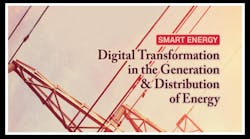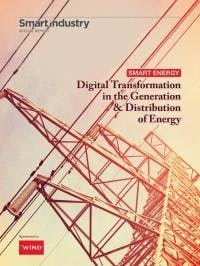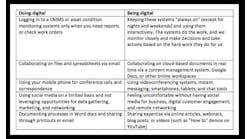While digitalization is (increasingly) affecting every industry, the energy sector is experiencing unrivaled disruption courtesy of new digital tools and techniques. This is a good thing, says Glenn Seiler, Wind River VP of Linux Solutions, and Wind River Europe/Middle East/Africa (EMEA) Sales Senior Director Nico Sfingopoulos, who share their perspectives here…
Smart Industry: What are the greatest drivers, globally, affecting energy digitalization?
This article is from the Wind River Special Report "SMART ENERGY Digital Transformation in the Generation & Distribution of Energy." Click the cover to get your copy.
What challenges are unique in the energy space?
Nico: Following the COP21 Paris Agreement, European countries committed to reduce CO2 emissions with target goals and milestones. For France the target is 40% reduction (compared to 1990) by 2030 and 75% by 2050. This target is challenging and will require huge investments in renewable.
But there are several challenges with the renewable energy. It is almost unpredictable—it is produced when and where there is wind, sun, rivers or tides. It will become very complicated renewable energy with prices paid to energy providers. If the energy is sold locally, the price drops when production is high. To encourage providers to invest in areas where the renewable efficiency is high, the transmission system operator (TSO) and the distribution system operator (DSO) must offer to investors a correct energy price.
The current TSO and DSO revenue model based only on energy consumption is no longer relevant. Their business model will move from transport and distribution to a marketplace in charge of balancing the network from the energy perspective but also in terms of energy price.
Glenn: There are numerous drivers, some are technically oriented to enable growth while others may be more business oriented to drive growth and profitability. The business drivers are similar to what we saw in the telecom industry in the 2000s; TSOs want to reduce dependency on OEMs and expand the vendor ecosystem while lowering their costs and innovating faster. Open source holds the promise of delivering on these key business drivers. The need to innovate quickly is being driven by the need to adapt to changing grid dynamics (infeed, flow patterns and more distributed control).
At the highest level, a key business driver is the desire to have vendor-agnostic implementations, a convergence of utility practices, and to keep pace with the changing dynamics of grid uses at reasonable cost. There are also technology drivers. Again, at a high level these are data, analytics and connectivity. There is so much data available about usage patterns and needs; analytics are required to consume this data and turn it into business decisions on how to run substations. Everything is connected today; connectivity will improve administration and operations. Static subsystems built decades ago simply were not designed for this usage.
Smart Industry: How is the energy market in EMEA adopting digital approaches differently than in the US?
Nico: The global energy market started to look to digitalization in 2016 after the Paris COP21 Agreement. Transmission (TSO : high voltage) and distribution (DSO : middle range and low range) European operators launched digitalization programs to modernize the power grid and adapt it to the new energy market context created by the urgency of temperature-increase limitation. We are seeing a trend acceleration in EMEA with strong milestone and budget commitment from major operators pushed by regulations, which are pushing operators to build the largest network to optimize renewable energy usage. In the US there is no global strategy, but some states like California and operators like Edison have started digitalization programs to locally optimize renewable energy.
Smart Industry: What are we talking about when we reference ‘energy digitalization’?
Nico: We are talking about the smart grid. Balancing (in real time) the network with 10,000+ providers, like in France, cannot be done with a centralized approach. It requires that some decisions must be made automatically/autonomously in the grid at the primary and secondary substation level, driven by data collected from almost all substations and consumers.
In this approach, the main substations will become datacenters hosting traditional protection and control applications, but also artificial intelligence applications that can exploit big data coming from the grid. They will be part of a large marketplace where energy can be traded, in real time, at better prices for both providers and consumers. This will require trusted trade technologies, such as blockchain.
Glenn: I want to be consistent with the terminology being used by LF Energy’s Digital Substation Workgroup. In this context, TSOs and DSOs require a new generation of Digital Substation Automation Systems (DSAS) that allow for more dynamic protection settings to protect against cyber-hacking and other security risks; similarly there are adaptative-automation functions that have aspects of AI and machine learning together with automated management. These are capabilities that simply cannot exist in power grids that are 100 years old. Also, as we stated earlier, data and the management of that data becomes a significant challenge that can only be addressed with digitalization.
Smart Industry: How does this affect energy providers and end users?
Glenn: For energy providers what we will see is more efficient use and transmission of energy products. For example the ability to understand demographics and utilize alternative power sources in under-served and areas of need. This could mean transferring wind-generated or water-generated power in areas where it is plentiful to areas that are underserved and do not have alternate power sources.
For the end-users this would, hopefully ,mean more consistent, more reliable energy and lower cost energy.
Nico: The traditional coal and gas pollutant plants will be required only to cover very short winter peaks. Then operation costs will make them unprofitable. They will be replaced by other storage-capacity solutions like steps (hydraulics storage), static batteries in substations, or electric cars that connect to the grid when charging.
The remaining battery charge can be used by the grid if needed. End users will also have the opportunity to become providers by adding wind turbines or solar panels in their roofs. Smart grids will optimize this energy usage and production, as well as the energy price for providers.
Smart Industry: Why are open systems critical to this new approach to energy production?
Nico: The digitalization request is pushing the energy sector to host in the grid applications coming from transversal domains. Traditional infrastructure providers are not able to provide complete solutions. Energy-grid actors are looking for open platforms to enable an ecosystem and to leverage modern software-scalable approaches like software define, cloud native and CI/CD. This is strategic for TSOs and DSOs to reduce software costs and their global productivity otherwise they would not able to finance the dramatic software increase in the grid consequences of digitalization. Energy providers will also have to connect to this smart grid if they want to get a fair price for their energy. Open platforms/standards are critical for digitalization as they enable interoperability between all the operators and providers of the future smart grid and energy market.
Glenn: What we are seeing emerge in the energy industry is very similar to what we have seen in the telecom industry over the last 10 years or so. Specifically, the economics of open source are compelling to any industry that is undergoing a digital transformation. Enterprise or IT companies (and specifically data-center types of use cases) were the first to adopt open source. In telecom these IT or data-center technologies began to converge with the telecom infrastructure (radio access networks) in the 2000s. Now we are seeing a similar move in the energy market, where IT and OT are converging in smart grid and substation use cases. Open systems will provide needed innovation and create a level, common playing field for critical infrastructure, which will enable more dynamic and heterogeneous solutions between vendors.
Smart Industry: How is IT/OT convergence different in the energy space than in other industries?
Nico: In substation digitalization, the computation capacity will increase continuously when the business cases are implemented. The OT system on the edge must be scalable. Merely adding cloud connectivity or gateways to traditional OT devices is not sufficient. It is more comparable on what is happening in the telecom market with 5G, where some business cases must be implemented in the edge due to latency requirements. The architecture will be based on on-premise clouds, where the critical and the IoT applications will be hosted.
Glenn: At the mega-trend level, the convergence is very similar across industries. IT technologies are pushing from the data center/cloud/headquarters down to the base on economies of scale, homogenous systems and standards.
The OT systems are aggregating up; in industrial you see Distributed Control Nodes (DCNs), in telecom you see Virtual Radio Area Network (vRAN), and in energy it is at the Digital Substation Automation System (DSAS). The convergence-point differs; in telecom it is at the central office; in industrial at the factory (but not the manufacturing floor itself) and in energy at the DSAS.
Smart Industry: What hardware components are enabling the digitalization of energy and how does virtualization technology come into play here?
Glenn: This is an interesting area that overlaps with the topic of IT/OT convergence. Some energy providers will continue to use existing hardware, which may be ARM-based. Increasingly you will see Intel-based architectures being put into the DSAS. For virtualization, I think the substations have been slow to adopt AI and virtualization. There may be a leap straight to container virtualization if there is not a lot of legacy VM based virtualization that needs to be supported. This is different than telecom, where there are thousands of VM-based legacy applications in use in the network.
As in nearly all markets, it will likely be a mixture of container-based and VM-based, but I think the substations are different in that there is not a lot of virtualization today.
The benefits of virtualization (whether container-based or VM-based) are many. The reuse of functions helps to keep the maintenance effort low. The ability to remotely update functions will lower OPEX and provide other benefits, like simulation and remote testing, on-boarding new functions. Virtualization also enables 2-layer or 3-layer decoupling of hardware, software and applications. This will enable hardware upgrades independent of software, which was more difficult in bespoke equipment.
Nico: The challenge for energy digitalization is to leverage virtualization to decouple applications from the hardware and to deal with energy-standard requirements. Critical infrastructure has strong requirements on reliability, performance, latency, cybersecurity and compliance with energy standards. It means the application and network-virtualization must rely on hardware-acceleration capabilities. Energy standards, like IEC 61850, enable technologies like TSN and PRP for reliability where specific hardware is required and must be supported in data-server architecture.
Smart Industry: Describe the push/pull strategy with energy customers.
Nico: Traditional tier1 and tier2 that are proving traditional energy solutions are reluctant to move from locked-customer turnkey-solution business models to open platforms. They see it as a threat for their current business. This digitalization is driven by TSO and DSO, where they see huge benefit not only in terms of capex and opex, but also in the opportunity to grow their business by creating a marketplace for energy transportation from providers to consumers. A push/pull strategy enables a digitalization-technology provider to promote his innovation to TSO/DSO/energy providers and end users, then to convince the energy-infrastructure provider to switch from devices-builder to a software-defined solution/application provider.
Glenn: Again, I will bring up the similarities from previous experience in telecom networks. For the longest time, OEMs controlled the supply chain with a ‘push’ model. They pushed their solutions to the energy provider. They created bespoke, proprietary systems; whether energy, telecom or industrial…doesn’t matter…it was the same model. These trends are very similar. Now the energy providers, through open systems, industry-specific forums such LF Energy and other standards initiatives, can create a ‘pull’ supply chain where they have more flexibility and can pull from multiple supply-side vendors.
Smart Industry: What most excites you about the near future of energy?
Nico: The current change in energy markets is not just a business optimization to reduce cost and increase productivity using new software and hardware technologies. This a complete revolution that will change all markets for the next 50 years. It will change the way energy actors (tier1, tier2, energy providers, consumers, TSO, DSO, and innovating startups) operate and do business together. This is not only a fantastic business opportunity. This is also a great opportunity to contribute to humanity’s challenge to counter climate change.
Glenn: As an open-source professional, the discussions around new software architectures to meet the DSAS requirements is exciting. But more importantly, as a consumer and citizen, the concept of a ‘fluid’ or dynamic energy grid is really fascinating. Ideally this might mean we get to a point where we can generate considerable power at lower-cost areas, then transfer it to high-use areas. This could have considerable positive impact on the environment and reduce dependency on non-renewable power resources.



